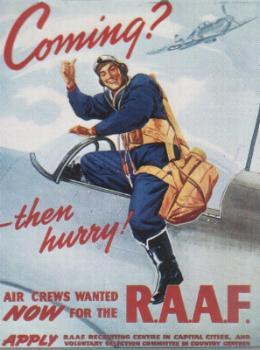
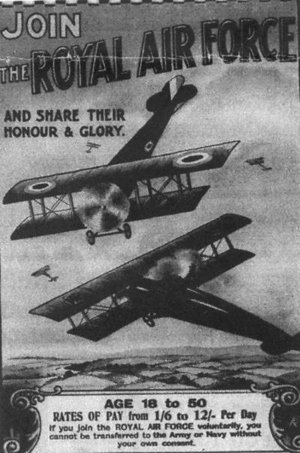


With posters enticing enrolments what young man or woman would resist such a challenge?
Air Force propaganda glamorised the pilot, especially the fighter pilot. The pilots always received the decorations and the promotions etc., however it was soon apparent that although most aircrew members wanted to be a pilot, very few would be selected for pilot training. Contrary to the air force propaganda many of the dare devil and potentially possibly some of our greatest airmen were scrubbed from the pilot's course for low flying, and from other categories because the going was too tough and the qualifications too demanding, with close on 50% failing the air crew course. Many of the aircrew were judged and assessed for further training, in an interview before a pre–selection board, of a couple of regular air force pilots, plus three educational instructor school teachers. They pre–judged all airmen by their appearance and their exam marks. In the Royal Australian Air Force aircrew aspirants were never given a chance, nor a test as to their suitability as pilots.
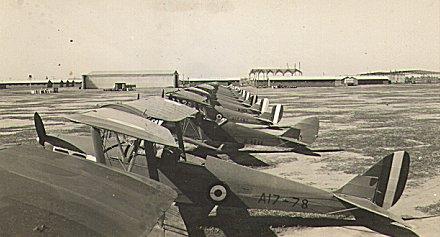
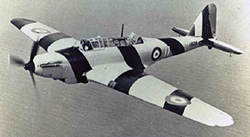
The Fairey Battle was shown to be inadequate as a day bomber early in WWII, but entered widespread use as a trainer and target tug with various Commonwealth air forces. Under the Empire Air Training Scheme (EATS), Australia took delivery of 366 of the type between June 1940 and December 1943. The Fairey Battle was withdrawn from RAAF use in 1949.
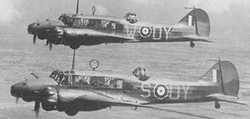
The Anson was the RAAF's first retractable undercarriage, low wing monoplane, and served in great numbers (1,028 aircraft) following 1935 orders, when the RAAF set out to modernise its equipment.
It stayed in service until 1955, when the few remaining examples of this faithful machine were terribly outmoded.
It was initially intended for general reconnaissance, and particularly maritime patrol. The majority were GR.1 versions, delivered between 1936 and 1938. It began to be replaced in the maritime role by the Lockheed Hudson from 1940. Already dated, the Anson moved to its well–remembered role as a multi–engine, observers, gunners and navigators training aircraft within the Empire Air Training Scheme. 66, 67, 71 and 73 Sqns. continued anti–submarine patrols off eastern Australia from 1942.
Bomber Command, and 460 squadron veteran Laurie Woods speaking at his Sunnybank home in Queensland said one of the more exciting episodes of his service life was when, a couple of Japanese submarines, were reported off Adelaide.
"At Air Observers School at Mt. Gambier, South Australia, our first flying training school my first sight of an aeroplane doing a night landing and my first flight in an aeroplane on the 28th September, 1942. We were flying in an old Anson, twin engine bomber, built with a light metal frame and covered in fabric. Although slow, with an average cruising speed of 120mph they were a fairly stable aircraft and reasonably safe.
In company with two West Australian trainees, we lined up beside the plane, with the pilot. He held out a sickie bag to each one of us, saying: "It is no disgrace for an aircrew trainee to be airsick on their first flight". For the next hour he did everything possible to make us airsick. One of the fellows succumbed and held the bag out to me and yelled: "What do I do with this!" I pointed out the window not wanting him to upset my stomach by sticking his bag under my nose.
Suddenly I had a thought, I hope he doesn't jump out the window himself. I grabbed him, taking the bag from him and threw it out myself. To me the hardest part of flying in Ansons was the winding up of the landing gear after take off, and winding it down before coming in to land.
With only a few hours flying experience we were briefed in eight Anson planes for an air search out over Spencers Gulf following a report Japanese submarines had been sighted. In company with a half dozen Beaufighter night fighter/bombers (nicknamed "Whispering Death" by the Japanese, as they couldn't be heard until right over you), led by Squadron/Leader (Wiry Whiskers) McCormack, we set out on an exiting and exhilarating search.
What if we spotted a Jap submarine, we could drop our aluminium 11 lbs sea markers which was our only offensive weapon to mark the spot and call the Beaufighters. We would be having a grandstand view of the submarines being blasted out of the water. What if they were surfaced and started firing at us, could we get away quick enough. We never did get an answer, We flew over the sea on 12th October 1942 and again on the 14th October 1942 flying a three–hour sweep across Spencers Gulf. What a disappointment, no sightings of submarines were made.
The Beaufighter leader Squadron/Leader McCormack, with "Biggles" type wiry whiskers, twirled on the end, the imagery of the real fighter pilot stuff, with tunic top button undone, proved too much for the station pilots and officers. After a drinking session they got the Squadron Leader down, cut off his moustache from one side of his face, and ruined his ego. He left Mount Gambier station as mad as hell".
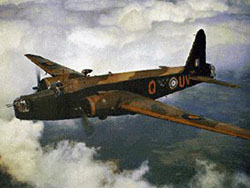
460 Squadron, RAAF, was equipped with Vickers Wellingtons from March to December, 1942. Squadron crews flew on 76 0perations in these aircraft, raiding targets in centres such ads Hamburg, Dortmund, Cologne and Wilhelmshaven. Affectionately named the "Wimpy" after a cartoon character, the Wellington was a twin engined bomber that doubled in many roles in Coastal and Training Commands. The Wimpy was the only bomber aircraft brought into service before the war began and was still in service well after the wars end. Specified as early as 1932, Vickers produced the first Wellington in 1936. These aircraft were fitted with Bristol Pegasus engines. Later Rolls Royce Merlins and Bristol Hercules were used. Over 11,000 were produced before manufacturing ceased in 1945. Of Geodetic Construction (cross membered) developed by Dr. Barnes Wallis of Dambuster fame, Wimpy was immensely strong. I action it was able to absorb horrific damage and still remain controllable. The aircrafts first operation against the enemy was an attack on German warships at Wilhelmshaven in 1939 and its last raid was on Previso in Northern Italy in April 1945.
Controls were heavy, particularly during an approach to a landing Nevertheless, a wonderful aircraft. 11,000 Wimpys proved it.
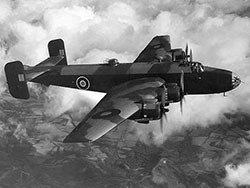
Following on from Operational Training Units, flying the Wellington twin engined plane, air crews being posted to Bomber Command heavy bomber units, then converted on to four engined Halifax bombers. Flying in the Halifax, Gee bombings following on cross country flights and maybe a diversionary raid far out over the North Sea were carried out. Having flown 15 hours night and 15 hours daylight converting to the four engined plane, then some aircrews were then posted to squadrons flying "Halibags" whilst others after converting onto the four engined bombers were then posted to Lancaster squadrons.
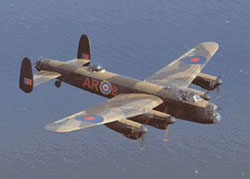
460 Squadron converted to Lancasters during September 1942. The Avro Lancaster was judged to be the most able bomber used during WWll. In 1945 it reached the summit of its effectuality by lifting and delivering a colossal 10 ton "Grand Slam" Earthquake bomb to the German submarine pens in Europe. Previously unbreachable reinforced concrete was smashed, resulting in large submarine losses. Its manoeuvrability was demonstrated when 617 (Dambuster) Squadron raided the Mohne, Eder and Scorpe dams. A pilot friendly aircraft that was a pleasure to fly. All who flew the Lanc had nothing but praise. Landings were almost "Tiger Mothish", the aircraft floating along the runway, asking for a perfect three point landing. Yet she was born a failure. Designed by Roy Chadwick for A.V.Rowe Ltd. and called the Manchester, it was fitted with two Rolls Royce Vulture engines, a new type that proved to be troublesome. The aircraft could not carry its designed bomb load and was difficult to fly. Chadwick redesigned the wing and fitted four Rolls Royce Merlins creating the mighty Lancaster. Of almost 1,000,000 tons of bombs dropped by the RAF, the Lancaster carried 610,000 tons. This was the noblest aircraft of the all. Its flying qualities were gentle and the design factors so combined, that all its crews could stand up and say, THIS WAS THE LANCASTER
Oh what an aeroplane
THE AVRO LANCASTER.